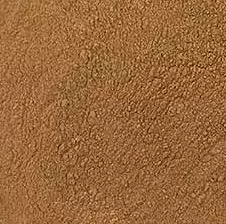| "Descrizione" by FCS777 (5554 pt) | 2024-Mar-28 16:09 |
Review Consensus: 10 Rating: 10 Number of users: 1
| Evaluation | N. Experts | Evaluation | N. Experts |
|---|---|---|---|
| 1 | 6 | ||
| 2 | 7 | ||
| 3 | 8 | ||
| 4 | 9 | ||
| 5 | 10 |
Rhododendron ferrugineum leaf cell culture extract is the cell culture extract of Rhododendron ferrugineum leaves obtained by a mechanical and chemical process involving different processing steps:
- selection of the raw material
- fine grinding by mechanical process
- mechanical extraction
- microconcentration by mechanical means
- chemical purification
- drying by mechanical process
- crushing by mechanical process
The procedure is completed with a product test.
It appears in the form of a brown powder.

What it is used for and where
Rhododendron ferrugineum is a shrub belonging to the Ericaceae family, distributed at high altitudes. Bioactive compounds such as ledol and palustrol are present in the leaves.

Cosmetics
Rhododendron ferrugineum leaf cell culture extract makes use of the antioxidant and antifungal bioactive compounds in the leaves that eliminate cationic radicals.
Skin conditioning agent. It is the mainstay of topical skin treatment by restoring, increasing or improving skin tolerance to external factors, including melanocyte tolerance. The most important function of the conditioning agent is to prevent skin dehydration, but the subject is rather complex and involves emollients and humectants.
Medical
Also in medical applications, Rhododendron ferrugineum has shown interesting activities: an aqueous extract from the aerial parts enriched with polyphenols abolished the entry of the herpes simplex virus (1). Other studies have confirmed its antioxidant and antimicrobial activities (2).
CAS 90106-21-1
EC number 290-243-0
For more information:
Rhododendron ferrugineum studies
References______________________________________________________________________
(1) Gescher K, Kühn J, Hafezi W, Louis A, Derksen A, Deters A, Lorentzen E, Hensel A. Inhibition of viral adsorption and penetration by an aqueous extract from Rhododendron ferrugineum L. as antiviral principle against herpes simplex virus type-1. Fitoterapia. 2011 Apr;82(3):408-13. doi: 10.1016/j.fitote.2010.11.022.
(2) Rezk A, Al-Hashimi A, John W, Schepker H, Ullrich MS, Brix K. Assessment of cytotoxicity exerted by leaf extracts from plants of the genus Rhododendron towards epidermal keratinocytes and intestine epithelial cells. BMC Complement Altern Med. 2015 Oct 15;15:364. doi: 10.1186/s12906-015-0860-8.
Abstract. Background: Rhododendron leaf extracts were previously found to exert antimicrobial activities against a range of Gram-positive bacteria. In this study, we investigated which of the extracts with these antimicrobial properties would be best suited for further exploitation. Specifically, the project aims to identify biologically active compounds that affect bacterial but not mammalian cells when applied in medical treatments such as lotions for ectopic application onto skin, or as orally administered drugs. Conclusions: We conclude that leaf extracts from highly potent antimicrobial R. minus and R. racemosum are safe to use at 50 μg/mL in 24-h incubations with HaCaT keratinocytes and IEC6 intestine epithelial cells in monolayer cultures. Extracts from R. rubiginosum as well as R. concinnum or R. ferrugineum are applicable to either keratinocytes or intestinal epithelial cells, respectively. Beyond the scope of the current study, further experiments are required to identify the specific compounds contained in those Rhododendron leaf extracts that exert antimicrobial activity while being non-cytotoxic when applied onto human skin or gastrointestinal tract mucosa. Thus, this study supports the notion that detailed phytochemical profiling and compound identification is needed for characterization of the leaf extracts from specific Rhododendron species in order to exploit their components as supplementary agents in antimicrobial phyto-medical treatments.
| Evaluate |

